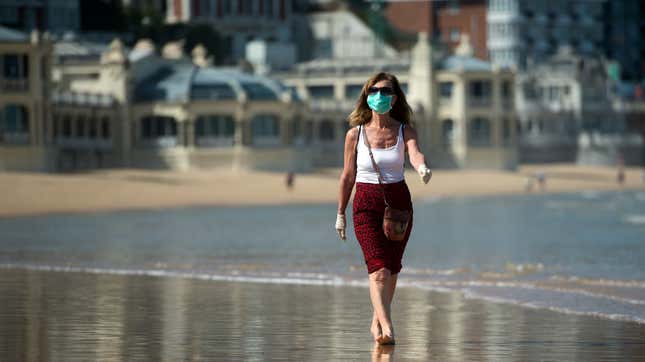
The U.S. is still in the throes of the coronavirus pandemic: The death toll is climbing and quarantining is becoming increasingly unbearable. With summer around the corner, people are going to want to get outside again.
While other illnesses are mostly seasonal—the flu, for instance, thrives in wintry conditions more than warm ones—it’s still unclear whether the warmer weather will abate the spread of the coronavirus. That means we should be planning to social distance through the heat.
“We don’t know if the novel coronavirus is modulated by temperature or humidity, and we don’t know if that modulation, if it does exist, will be enough to slow the transmission of the virus,” Jeffrey Shaman, a climate and health expert at Columbia University, told Earther.
Scientists have been racing to figure out answers as warmer weather approaches in the northern hemisphere. The latest addition to the growing body of coronavirus and weather research is a study published last week in the Canadian Medical Association Journal found that in countries around the world, differences in temperature and humidity had little bearing on the coronavirus’ progression.
“The message is simple: Summer won’t help us to resolve this problem,” Peter Jüni, a clinical epidemiologist at the Institute for Health Policy, Management and Evaluation at the University of Toronto and study co-author, told Earther in an email.
In early March, the study’s authors examined 144 areas around the world where the virus was in the early stages of spreading, including parts of the U.S., Pacific Islands, and Australia. They first determined what the heat and humidity conditions were and what social distancing precautions were in place in each location at the beginning of the month. Then, after a 14-day incubation period to give public health measures some time to take effect, they followed the pandemic’s development from March 21 to March 27. While the social distancing measures had a big impact, heat and humidity made little to no difference.
The findings surprised the scientists, as they stand in stark contrast with their expectations. Preliminary research had suggested temperature and humidity (and therefore latitude) would be relevant to the virus’ spread, including a slew of studies from March and April that have yet to be peer reviewed. Those papers all showed signs that heat and humidity may reduce the virus’ transmission, though only modestly. Jüni said his team’s new study is far more rigorous than their preliminary research.
“When inspecting our data, we found implausible outliers that likely contributed to the initial impression of an association,” he said.
Other recent research is in line with Jüni’s group. A new study from the MIT’s Sloan School of Management—which has not yet been published or reviewed—found that we shouldn’t expect warm weather will kill off the coronavirus. Another study conducted in China that has been peer reviewed also found no relationship with heat, noting the “spread ability of covid-19 would not change with increasing temperature.”
Jüni said he and his team are “confident that [their] current results are much more robust and therefore definite.” Shaman, however, said that experiments like theirs, which examine covid-19's behavior in the wild, aren’t necessarily the best way to learn about its interaction with weather. There are so many human factors that can influence how much a virus spreads that can be hard to control for, so isolating the impact of temperatures is challenging.
“It would be better if we could see it in a controlled laboratory environment, too,” he said.
He suggested an experiment in the style of one published in the New England Journal of Medicine last month that examined the virus’ ability to survive on surfaces and in the air under controlled temperature and humidity.
“I would love to see that repeated at multiple different conditions so we could see about in any way modulates the viability of the virus over time,” he said.
The problem is, those studies won’t be easy or quick to do. They require special facilities and lab time that can be hard to come by. The Department of Homeland Security has conducted such a study that suggests the virus survives best in dry conditions, but it’s results haven’t been peer-reviewed.
Even in the absence of definitive lab experiments and a variety of findings across the literature, we shouldn’t assume summer heat will stop this thing. But there is one thing all of these studies show is an effective tool to manage spread: social distancing measures.
“Only area-wide public health interventions were consistently associated with reduced epidemic growth, and the greater the number of co-occurring public health interventions, the larger the reduction in growth,” the new Canadian Medical Association Journal study says. “These findings suggest that seasonality is likely to play only a minor role in the epidemiology of COVID-19, while public health interventions (school closures, restricting mass gatherings, social distancing) appear to have a major impact.”
That not only means it’s too soon to reopen economies absent clear public health plans, it also means more needs to be done to ensure people can stay home sustainably through the summer heat. Because as Jüni said, when it comes to social distancing, we’re in it for the long haul—perhaps a year or more.
“We all need to get ready now for a marathon,” he said.